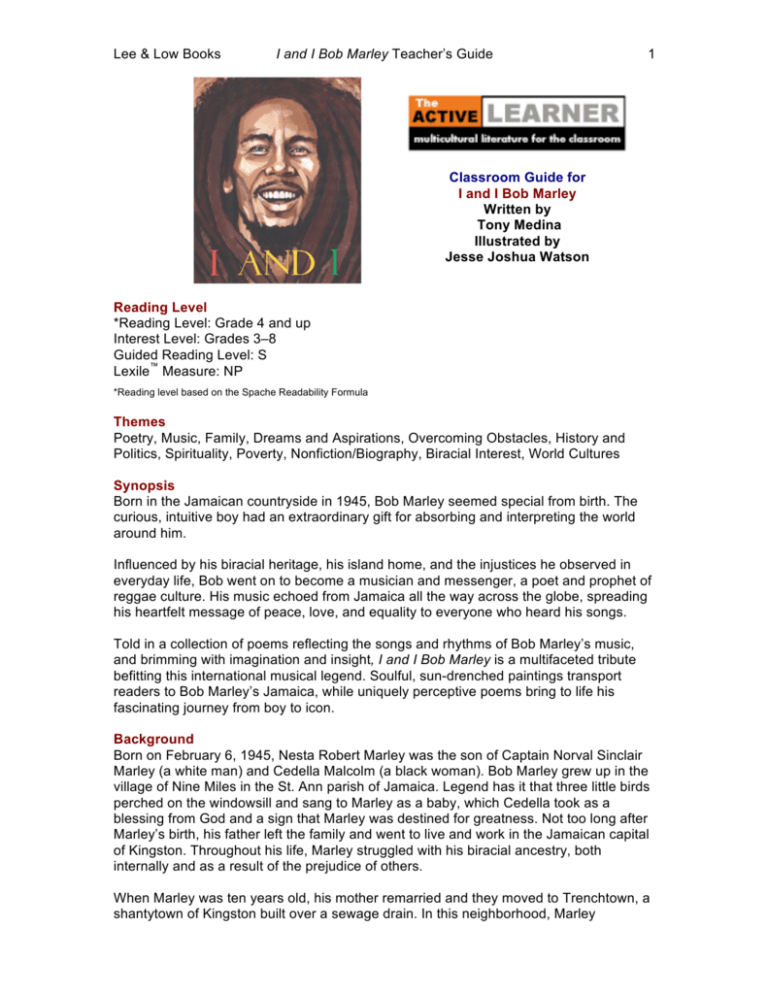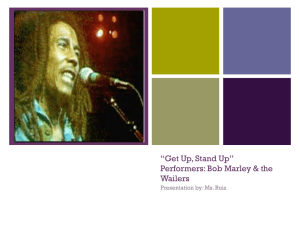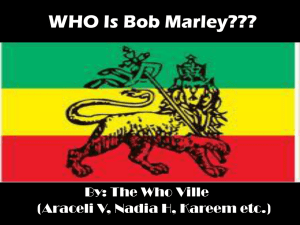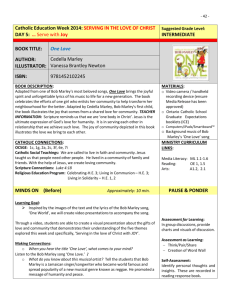
Lee & Low Books
I and I Bob Marley Teacher’s Guide
1
Classroom Guide for
I and I Bob Marley
Written by
Tony Medina
Illustrated by
Jesse Joshua Watson
Reading Level
*Reading Level: Grade 4 and up
Interest Level: Grades 3–8
Guided Reading Level: S
Lexile™ Measure: NP
*Reading level based on the Spache Readability Formula
Themes
Poetry, Music, Family, Dreams and Aspirations, Overcoming Obstacles, History and
Politics, Spirituality, Poverty, Nonfiction/Biography, Biracial Interest, World Cultures
Synopsis
Born in the Jamaican countryside in 1945, Bob Marley seemed special from birth. The
curious, intuitive boy had an extraordinary gift for absorbing and interpreting the world
around him.
Influenced by his biracial heritage, his island home, and the injustices he observed in
everyday life, Bob went on to become a musician and messenger, a poet and prophet of
reggae culture. His music echoed from Jamaica all the way across the globe, spreading
his heartfelt message of peace, love, and equality to everyone who heard his songs.
Told in a collection of poems reflecting the songs and rhythms of Bob Marley’s music,
and brimming with imagination and insight, I and I Bob Marley is a multifaceted tribute
befitting this international musical legend. Soulful, sun-drenched paintings transport
readers to Bob Marley’s Jamaica, while uniquely perceptive poems bring to life his
fascinating journey from boy to icon.
Background
Born on February 6, 1945, Nesta Robert Marley was the son of Captain Norval Sinclair
Marley (a white man) and Cedella Malcolm (a black woman). Bob Marley grew up in the
village of Nine Miles in the St. Ann parish of Jamaica. Legend has it that three little birds
perched on the windowsill and sang to Marley as a baby, which Cedella took as a
blessing from God and a sign that Marley was destined for greatness. Not too long after
Marley’s birth, his father left the family and went to live and work in the Jamaican capital
of Kingston. Throughout his life, Marley struggled with his biracial ancestry, both
internally and as a result of the prejudice of others.
When Marley was ten years old, his mother remarried and they moved to Trenchtown, a
shantytown of Kingston built over a sewage drain. In this neighborhood, Marley
2
discovered a sense of belonging and his love of music. He was influenced by the local
music scene as well as by American R&B broadcasts he heard on the radio. At the age
of fourteen, Marley dropped out of school to pursue music full-time and formed a band,
the Wailing Wailers. He later met and married his wife, Rita Anderson, and over the
course of his life became a legendary musician and an ambassador for the Rastafarian
movement, Jamaica, and reggae music to the rest of the world.
(For additional detailed information about Bob Marley’s life, please refer to “Notes for I and I Bob
Marley” at the end of the book.)
Jamaica is an island country located in the Caribbean Sea and part of a group of islands
called the Greater Antilles. Christopher Columbus claimed Jamaica for Spain after he
landed there in 1494. In 1655 the British took full control of the country. By the late
1700s, Jamaica had become one of the largest African slave markets for the Western
Hemisphere. After many slave uprisings, slavery was abolished in 1838. Starting in the
mid-1900s, Jamaica slowly gained independence from the United Kingdom, and in 1962,
it attained full independence. Students can find more information about Jamaica’s
history, geography, and wildlife online at National Geographic Kids and other sites.
BEFORE READING
Prereading Focus Questions
(Reading Standards, Informational Text, Craft & Structure, Strand 5 & Reading Standards, Literature, Craft &
Structure, 5)
Before introducing this book to students, you may wish to develop background and
promote anticipation by posing questions such as the following:
1. What kinds of music do you like? Why do you like them? Tell us what you know
about the origins of your favorite kind of music.
2. Have you ever heard of the musician Bob Marley? What do you already know about
him? About his music?
3. What do you know about the island country of Jamaica? What do you think it would
be like to live there?
4. What are some of your goals? What have you done to try and achieve them? How
do you deal with obstacles?
5. What is a biography? Why are biographies of interest to readers? What biographies
have you read?
Exploring the Book
(Reading Standards, Informational Text, Craft & Structure, Strand 5 & Reading Standards, Literature, Craft
& Structure, 5)
Open the book so students can see the front and back covers simultaneously, and read
the title aloud as: I and I Bob Marley. Ask students what they think “I and I” means. You
may wish to read students the “About the Title” note on the copyright page to help
encourage discussion.
Ask students who they think the person on the front cover is. Invite them to comment on
the illustration and how it might relate to the title of the book.
Take students on a book walk and draw attention to the following parts of the book: title
page, dedications, acknowledgment, author’s sources, introduction, poems and
illustrations, and extensive “Notes for I and I Bob Marley” at the end of the book.
Ask students to predict what the book is going to be about. Which parts of the book did
they use as clues to making their predictions?
3
Setting a Purpose for Reading
(Reading Standards, Informational Text, Key Ideas and Details, Strands 1–3 & Reading Standards,
Literature, Key Ideas and Details, Strands 1–3)
Have students read to find out:
• who Bob Marley was and why he is an important historical figure
• how Bob Marley contributed to music
• how Bob Marley contributed to his community and the world
VOCABULARY
(Reading Standards, Informational Text, Craft and Structure, 4 & Reading Standards, Literature, Craft and
Structure, 4)
The book contains several words and terms that may be unfamiliar to students. Based
on students’ prior knowledge, review some or all of the vocabulary below. Then ask
students to write their own meanings and sentences for each word and term. If students
also know synonyms for any of the vocabulary, have them list the synonyms as well.
GENERAL VOCABULARY
chile
Africa
roam
lifelines
bamboo
thickets
grimy
rickety
rude boys haggard
hook up
mentors
blaring
hypnotizing
expanse redemption
tornado
unleashed
atwirl
Ethiopia
natty dread parish
shantytown dance hall
hurled
hailed
sardine
guava
Europe
duppy
prophet
cranky
beanie man
makeshift
sassy
Jah
musty
rubble
port-of-call
raggedy
dreads
blessed
swirl
scrape and fuss
read palms
conqueror
hurricane
tuff gong seer
potbelly
monsoon wind
dominoes
Marcus Garvey
ghetto life
running the streets
hardship
police baton
down-pressed consciousness
Rasta Man
Emperor Haile Selassie
Zion
Christopher Columbus
Maroons
King’s English
sufferers
Zimbabwe
fate
windswept
MUSIC-RELATED VOCABULARY
roots
rock
reggae
ska
wail
blues
jazz
R&B
guitar riffs brassy
skank dance blues man
troubadour rock steady rhythm
harmony
doo-wop ditties
lyrics
AFTER READING
Discussion Questions
After students have read the book, use these or similar questions to generate discussion,
enhance comprehension, and develop appreciation for the content. Encourage students
to refer to passages and photographs in the book and to cite evidence from the text to
support their responses.
Literal Comprehension
Refer to the first poem, “I Am the Boy from Nine Miles.” Who is the narrator of the
poem? How do you know? (Reading Standards, Literature, Craft and Structure, 6)
2. Look back at the poem “My Heart the Island.” What event in Bob Marley’s life is this
poem about? How does he feel about his mother? About his father? What did you
learn about his parents? How is this information important to understanding Bob
Marley? (Reading Standards, Literature, Key Ideas and Details, 1–3 & Craft and Structure, 5–6)
1.
4
3. In the poem “Palm Reader,” what does Bob Marley do? How does he feel about his
talent? How do you know? Cite evidence from the poem to support your answer.
(Reading Standards, Literature, Key Ideas and Details, 1–3 & Craft and Structure, 5–6)
4.
Refer to the poem “When My Papa Sends for Me.” How does the narrator feel about
what is happening? Describe his journey from Nine Miles to Kingston. (Reading
Standards, Literature, Key Ideas and Details, 1–3 & Craft and Structure, 5–6)
5.
What happens to Bob Marley when he gets to Kingston? How does he feel about his
father? Who takes care of him? What does he do all day? What does he learn from
the beanie man? (Reading Standards, Literature, Key Ideas and Details, 1–3 & Craft and Structure,
5–6)
6.
Where does Trenchtown get its name? What kind of place is it? How would you
describe it? What clues did you find in the poem “Trenchtown”? What is a rude boy?
How do you know? (Reading Standards, Literature, Key Ideas and Details, 1–3 & Craft and
Structure, 4)
7.
Where does Bob Marley learn about music? How old is he when he joins his first
band? How does his mother feel about it? (Reading Standards, Literature, Key Ideas and
Details, 1–3 & Craft and Structure, 5–6)
8.
Look at the poem “Wailing Wailers.” Why does Bob Marley sing? What is he hoping
to do with his music? Cite evidence from the poem to support your answer. (Reading
Standards, Literature, Key Ideas and Details, 1–3 & Craft and Structure, 5–6)
9.
In the poem “Underneath a Plum Tree,” what happens to Bob Marley? Who does he
meet? How does he feel about her? How do you know? (Reading Standards, Literature,
Key Ideas and Details, 1–3 & Craft and Structure, 5–6)
10.
What is the poem “Island Song” about? Who does Bob Marley want to take his island
back from? What does Christopher Columbus have to do with it? Cite evidence from
the poem to support your answer. (Reading Standards, Literature, Key Ideas and Details, 1–3 &
Craft and Structure, 6)
11.
In the poem “Music Takes Me,” what has happened to Bob Marley? What is his
message? How do you know? (Reading Standards, Literature, Key Ideas and Details, 1–3 &
Craft and Structure, 5–6)
12. What important event is described in the poem “Fate Opens Up Its Hand”? How does
this event change Bob Marley’s life? Cite evidence from the poem to support your
answer. (Reading Standards, Literature, Key Ideas and Details, 1–3 & Craft and Structure, 5–6)
Extension/Higher Level Thinking
1. Refer to the poem “I Am the Boy from Nine Miles.” What is Nine Miles? How do you
know? What clues does the author give you? (Reading Standards, Literature, Key Ideas and
Details, 1–3 & Craft and Structure, 4)
2.
Look at the poem “My Heart the Island.” What do you think the poem’s title means?
How can a heart be an island? (Reading Standards, Literature, Key Ideas and Details, 1–3 &
Craft and Structure, 4–6)
3. In the poem “Palm Reader,” the author uses a lot of comparative language. To what
does he compare lifelines? What does the narrator see buzzing like a beehive and
hear humming like music? How do you know? (Reading Standards, Literature, Key Ideas and
Details, 1–3 & Craft and Structure, 4–6)
4. In the poem “When My Papa Sends for Me,” to what does the narrator compare his
sadness? What two weather images are used? Cite evidence from the poem to
support your answer. (Reading Standards, Literature, Key Ideas and Details, 1–3 & Craft and
Structure, 4–6)
5. In the poem “In Kingston,” what is a beanie man? What does he do? How do you
know? (Reading Standards, Literature, Key Ideas and Details, 1–3 & Craft and Structure, 4–6)
6. What mood is conveyed in the poem “Trenchtown”? What images is the narrator
hoping to give the reader? How does the illustrator help create this mood? Cite
5
evidence from the poem to support your answer. (Reading Standards, Literature, Key Ideas
and Details, 1–3 & Craft and Structure, 4–6)
7. In the poem “At Fourteen,” what does the word “wail” mean? What does “running the
streets” mean? How do you know? (Reading Standards, Literature, Key Ideas and Details, 1–3
& Craft and Structure, 4–6)
8. Besides music, what is important to Bob Marley? What parts of his personal history
and his country’s history impacted him? How do you know? (Reading Standards,
Literature, Key Ideas and Details, 1–3 & Craft and Structure, 5–6)
9. In the poem “Underneath a Plum Tree,” how does the narrator use weather imagery
to describe Rita? Cite evidence from the poem to support your answer. (Reading
Standards, Literature, Key Ideas and Details, 1–3 & Craft and Structure, 4–6)
What is a Rasta man? Who are some people who influenced Bob Marley? What
does he have in common with them? Cite evidence from the poems to support your
answer. (Reading Standards, Literature, Key Ideas and Details, 1–3 & Craft and Structure, 4–6)
11. What tone is conveyed in the poem “Island Song”? What is the tone of the poem
“Reggae”? What clues do the author and illustrator give you? Cite evidence from the
poems to support your answer. (Reading Standards, Literature, Key Ideas and Details, 1–3 &
10.
Craft and Structure, 4–6 & Integration of Knowledge and Ideas, 7 and 9)
12.
Look at the poem “Hope Road.” How does Bob Marley feel about making music?
What images are used to describe this feeling? (Reading Standards, Literature, Key Ideas
and Details, 1–3 & Craft and Structure, 4–6 & Integration of Knowledge and Ideas, 7 and 9)
13. Look again at the first poem, “I Am the Boy from Nine Miles,” and at the final poem,
“Song in My Heart.” What do you notice about the two poems? Why do you think the
author repeats so many lines and ideas from the first poem in the final poem?
(Reading Standards, Literature, Key Ideas and Details, 1–3 & Craft and Structure, 4–6)
Literature Circles
(Speaking and Listening Standards, Comprehension and Collaboration, Strands 1–3 & Presentation of
Knowledge and Ideas, Strands 4–6)
If you use literature circles during reading time, students might find the following
suggestions helpful in focusing on the different roles of the group members.
•
•
•
•
•
•
The Questioner might use questions similar to the ones in the Discussion Question
section of this guide.
The Passage Locator might look for lines in each poem that tell what part of Bob
Marley’s life the poem is about.
The Illustrator might create scenes on a timeline that follow the events in the text.
The Connector might find other books about Bob Marley and his music or stories
that are based on Marley’s songs.
The Summarizer might provide a brief summary of the group’s reading and
discussion points for each meeting.
The Investigator might look for information about other influential reggae musicians.
*There are many resource books available with more information about organizing and implementing
literature circles. Three such books you may wish to refer to are: GETTING STARTED WITH
LITERATURE CIRCLES by Katherine L. Schlick Noe and Nancy J. Johnson (Christopher-Gordon,
1999), LITERATURE CIRCLES: VOICE AND CHOICE IN BOOK CLUBS AND READING GROUPS by
Harvey Daniels (Stenhouse, 2002), and LITERATURE CIRCLES RESOURCE GUIDE by Bonnie
Campbell Hill, Katherine L. Schlick Noe, and Nancy J. Johnson (Christopher-Gordon, 2000).
Reader’s Response
(Reading Standards, Literature & Informational Text, Key Ideas and Details, Strands 1–3, Craft and
Structure, Strands 4–6, & Integration of Knowledge and Ideas, Strands 7–9)
Use the following questions and writing activities to help students practice active reading
and personalize their responses to the book. Suggest that students respond in reader’s
6
journals, essays, or oral discussion. You may also want to set aside time for students to
share and discuss their written work, if they wish to.
1. What kind of person was Bob Marley? How would you describe him? What did he
value? How did he act in the face of adversity? Of accomplishment? Write a short
paragraph that answers these questions about Marley. Cite parts of the poems to
support your ideas.
2. Which parts of Bob Marley’s life story did you connect with the most? Why? Which
parts of the text did you have a hard time connecting with? Why?
3. How do you think Bob Marley wanted his music to make people feel? Why do you
think he wanted people to feel that way? Use information from the poems to support
your answer.
4. How does this book affect your thinking about prejudice and the ways people are
sometimes treated by others?
5. Have students write a book recommendation explaining why they would or would not
recommend this book to other students.
ELL Teaching Activities
These strategies might be helpful to use with students who are English language
learners.
1. Assign ELL students to read the book aloud with strong English readers/speakers.
2. Have each student write three questions about the story. Then let students pair up
and discuss the answers to the questions.
3. Depending on students’ level of English proficiency, after the first reading:
• Review the illustrations in order and have students summarize what is happening
on each page, first orally, then in writing.
• Have students work in pairs to retell either the plot of the story or key details. Then
ask students to write a short summary, synopsis, or opinion about what they have
read.
4. Have students give a short talk about what they admire about a character or central
figure in the story.
INTERDISCIPLINARY ACTIVITIES
(Introduction to the Standards, page 7, “Students establish a base of knowledge across a wide range of
subject matter by engaging with works of quality and substance. They become proficient in new areas
through research and study. They read purposefully and listen attentively to gain both general knowledge
and discipline-specific expertise. They refine and share their knowledge through writing and speaking.”)
Use some of the following activities to help students integrate their reading experiences
with other curriculum areas.
Social Studies
Ask students to research Jamaica, its history, and its culture. Students may particularly
want to learn about some of the places referred to in the poems such as Kingston,
Trenchtown, and Nine Miles.
Social Studies/Music
Interested students may wish to learn more about some of the different kinds of music
mentioned in the book or some of the musicians who are referred to, such as James
Brown, Nat King Cole, Fats Domino, Little Richard, Sam Cooke, The Drifters, and so on.
Science
1. Ask students to research the weather in Jamaica. How is it similar to and how is it
different from the weather where you live? How does the weather in Jamaica and the
7
weather where you live affect the foods people grow and eat, how people dress, the
games people play, and so on?
2. The author uses several weather terms in his poems (monsoons, hurricanes,
tornadoes, etc.). Have students look through the poems and make a list of the
weather terms used. Then let each student choose one term and research the
characteristics that are unique to that kind of weather event. Students may then
compare and contrast their information.
Math
In the poem “In Kingston,” the author describes young Bob Marley visiting a vegetable
stand at the town market. If necessary for younger students, review how to measure
weight in pounds and ounces on a scale. Then bring in various fruits and vegetables for
students to weigh and record their results on a chart or graph. For older students, assign
a price per ounce or a price per pound for each food and ask students to figure out how
much various amounts of each fruit or vegetable would cost. For example: How much
would 11 ounces of tomatoes cost at 50¢ per pound? How much would 32 ounces of
potatoes cost at $1.08 per pound?
Writing/Art
1. Listen to Bob Marley’s song “Three Little Birds” or read the lyrics (the lyrics can be
found online here). What is the song’s message? How does the song make you feel?
Try writing a free verse poem about how the song affects you.
2. Imagine that the poem you wrote, or the lyrics for “Three Little Birds” as Bob Marley
wrote them, were to be included in the book I and I. Create an illustration for the
poem or lyrics. Try to use color to evoke the setting and feelings, as the illustrator did
in I and I.
ABOUT THE AUTHOR
Tony Medina is the author of Love to Langston; Christmas Makes Me Think; DeShawn
Days; and I and I Bob Marley; all published by Lee & Low Books. In addition, he has
written a book for young adults, FYI: Follow-up Letters to Santa from Kids who Never
Got a Response, and five volumes of poetry for adults, been included in more than
eighty publications, and edited several anthologies featuring the work of emerging poets.
An associate professor of Creative Writing at Howard University, Medina lives in the
Washington, DC, area.
ABOUT THE ILLUSTRATOR
Jesse Joshua Watson is a fine artist and an illustrator whose work has appeared in
galleries, on CD covers, and more recently in several children's books, including Lee &
Low’s Chess Rumble and I and I Bob Marley. An avid traveler, Watson's artwork reflects
the cultures and people he connects with along the way. Watson lives with his wife and
their sons in Port Townsend, Washington. His website is jessewatson.com
Book Information
$19.95, HARDCOVER
978-1-60060-257-3
$10.95, PAPERBACK
978-1-62014-030-7
48 pages, 9 X 11
*Reading Level: Grade 4 and up
*Reading level based on the Spache Readability Formula
Interest Level: Grades 3–8
Guided Reading Level: S
™
Lexile Measure: NP
8
Themes: Poetry, Music, Family, Dreams and Aspirations, Overcoming Obstacles,
History and Politics, Spirituality, Poverty, Nonfiction/Biography, Biracial Interest, World
Cultures
RESOURCES ON THE WEB
Learn more about I and I Bob Marley at:
http://www.leeandlow.com/books/364/hc/i_and_i_bob_marley
Order Information
On the Web:
http://www.leeandlow.com/order (general order information)
By Phone:
212-779-4400 ext. 25
212-683-1894
By Mail:
Lee & Low Books, 95 Madison Avenue, NY NY 10016
Copyright © 1997-2013 The Active Learner
Lee & Low Books, all rights reserved.
For questions, comments and/or more information
please contact us at general@leeandlow.com
act us at general@leeandlow.com









